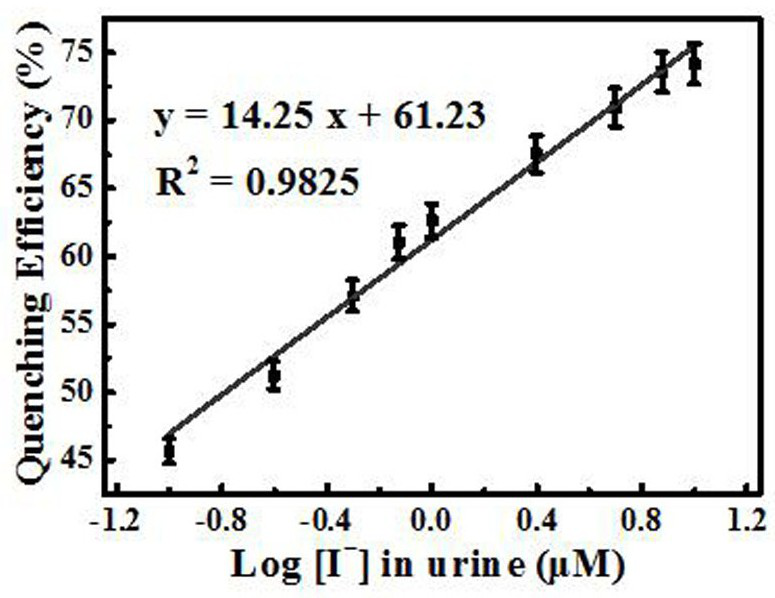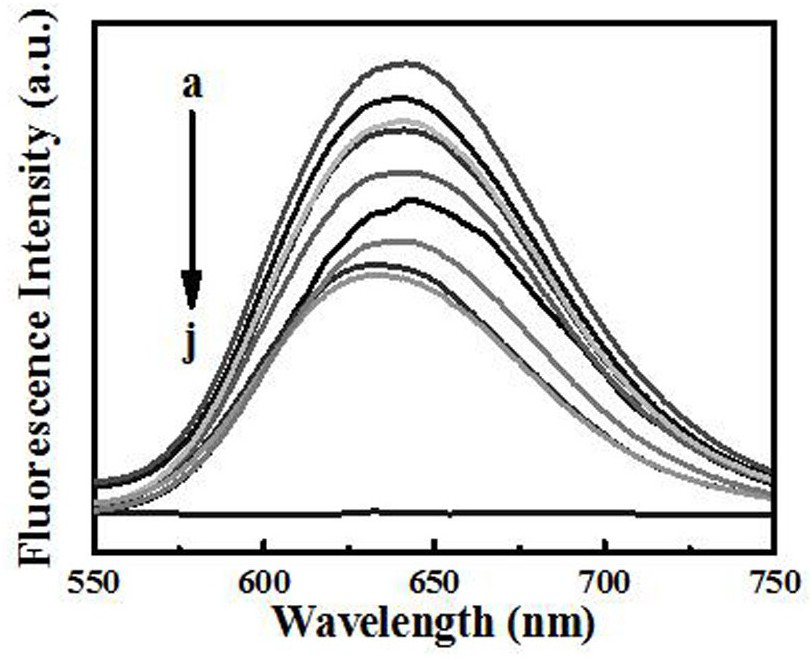A method for the detection of iodide ions in urine based on the fluorescence enhancement of silver nanoclusters induced by alcohol solvent
A silver nanocluster, fluorescence enhancement technology, applied in the field of biomedical analysis and detection, can solve the problems of time-consuming sample pretreatment process, high environmental requirements, time-consuming measurement, etc., and achieve the effects of visual rapid measurement, high sensitivity, and easy operation.
- Summary
- Abstract
- Description
- Claims
- Application Information
AI Technical Summary
Problems solved by technology
Method used
Image
Examples
Embodiment 1
[0037] Preparation of silver nanoclusters (AgNCs) probes with alcohol-induced fluorescence enhancement, the steps are as follows:
[0038] 1) Preparation of silver nanoclusters (AgNCs) materials:
[0039] a) At room temperature, 125 μL of 20 mM silver nitrate (AgNO 3 ) aqueous solution and 150 μL of 50 mM glutathione (GSH) were mixed, then 5.0 mL of ultrapure water was added, stirred and mixed evenly, and the pH was adjusted to 9-10 with 1.0 M NaOH aqueous solution to obtain solution A;
[0040] b) Mix 4.2 mg α-lipoic acid (LA) with 1.9 mg sodium borohydride (NaBH 4 ) mixed with 1 ml of ultrapure water, and stirred until LA was completely dissolved to obtain solution B. Take 700 μl of solution B and add it to solution A drop by drop. After stirring for 20 min, let it stand at room temperature for 1.5 h, and then centrifuge Separation and purification to obtain silver nanoclusters (AgNCs) materials, stored at 4°C in the dark, for later use;
[0041] 2) Preparation of silver ...
Embodiment 2
[0044] The method for detecting iodide ions in urine based on alcohol solvent-induced fluorescence enhancement of silver nanoclusters, using the silver nanocluster probe with alcohol-induced fluorescence enhancement prepared in Example 1 to measure iodide ions in urine (morning urine of children), the steps include:
[0045] The alcohol-induced fluorescence-enhanced silver nanocluster probes were sequentially added to equal volumes (100 μl) of the solution containing concentration gradients (0.050, 0.10, 0.25, 0.50, 0.75, 1.0, 2.5, 5.0, 7.5 and 10 μM). I - In the urine, the concentration of the probe was 1.05 mM, and the concentration of 1.0 M HCl aqueous solution or NaOH aqueous solution was used to adjust the pH to 6-8, react for 5 minutes, and observe the color change of the solution under an ultraviolet projector with a wavelength of 365 nm. , and using a fluorescence spectrometer, measure its fluorescence spectrum and intensity at the maximum excitation wavelength of 425 ...
Embodiment 3
[0047] The method for detecting iodide ions in urine based on alcohol solvent-induced fluorescence enhancement of silver nanoclusters uses the alcohol-induced fluorescence-enhanced silver nanocluster probe prepared in Example 1 to measure iodide ions in the urine to be tested (morning urine of pregnant women), and the steps are the same as the implementation Example 2, the results are shown in Table 1.
PUM
| Property | Measurement | Unit |
|---|---|---|
| particle diameter | aaaaa | aaaaa |
Abstract
Description
Claims
Application Information
 Login to View More
Login to View More - R&D
- Intellectual Property
- Life Sciences
- Materials
- Tech Scout
- Unparalleled Data Quality
- Higher Quality Content
- 60% Fewer Hallucinations
Browse by: Latest US Patents, China's latest patents, Technical Efficacy Thesaurus, Application Domain, Technology Topic, Popular Technical Reports.
© 2025 PatSnap. All rights reserved.Legal|Privacy policy|Modern Slavery Act Transparency Statement|Sitemap|About US| Contact US: help@patsnap.com



